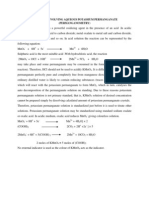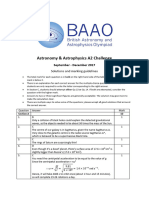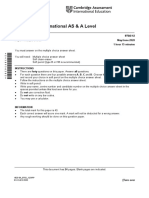Chemistry Practical Class 12 Instructions
Uploaded by
CR7STUDIO 7Chemistry Practical Class 12 Instructions
Uploaded by
CR7STUDIO 7Chemistry Practical Class 12
Instructions:
1. Read the document before you start writing the experiment.
2. Follow the instructions given in the document for writing experiment in the journal.
3. Use blue / black ink ball point pen only.
4. Practical Journal should be written in single colour ink only.
5. Material to be written on unruled page should also be written in pen only.
6. Do not write anything with pencil in journal.
INDEX
Sr. No. Experiment Date
1 To determine the concentration/molarity of KMnO4 solution by titrating
it against a 0.1 M standard solution of oxalic acid.
2 To determine the concentration/molarity of KMnO4 solution by titrating
it against a 0.1 M standard solution of ferrous ammonium sulphate.
3 To determine the functional group of given sample (-COOH)
4 To determine the functional group of given sample (-Ar-OH)
5 To determine the functional group of given sample (-CHO)
6 To determine the functional group of given sample (->C=O)
7 To determine the functional group of given sample (-NH2)
8 To determine the functional group of given sample (-OH)
9 To analyse the given salt ()
10 To analyse the given salt ()
11 To analyse the given salt ()
12 To analyse the given salt ()
13 To analyse the given salt ()
14 To analyse the given salt ()
Experiment-1
Part A:
Aim: Preparation of 0.1M standard solution of oxalic acid.
Material Required:
Apparatus: Standard flask (250 mL), Funnel, Chemical balance, beaker (250 mL), watch glass, glass
rod, spatula.
Chemicals: Oxalic acid.
Theory: Calculation for weighing oxalic acid for 0.1 M solution.
Molecular weight of Oxalic acid = 126 (H2C2O4 . 2H2O)
1M of Oxalic acid = 126 g/1000 mL
Therefore 0.1M = (0.1 X126 X 250) / 1000 = 3.15 g
Procedure:
1. Weigh an empty watch glass using a chemical balance.
2. Weigh 3.16g of oxalic acid accurately in the watch glass.
3. Dissolve weighed oxalic acid in minimum amount of water in 250 mL beaker and transfer it
to 250 mL standard flask.
4. Now wash the 250 mL beaker with distilled water.
5. Make the solution up to the marked point with distilled water and make sure the oxalic acid
fully dissolved.
6. This solution is 0.1M standard solution of oxalic acid.
Part B
Aim: To determine the concentration/molarity of KMnO4 solution by titrating it against a 0.025 M
standard solution of oxalic acid.
Material Required:
Apparatus: Standard flask (250 mL), Burette (50 mL), Burette stand , Pipette (20 mL), Conical flask
(250 mL), Funnel, flask, Glazed tile(white), Burner, Wire gauze, Chemical balance, beaker (250 mL),
watch glass, glass rod, measuring cyclinder (50 mL).
Chemicals: 0.1 M Oxalic acid, Potassium permanganate solution, dil. Sulphuric acid
Theory: In the present experiment, potassium permanganate acts as a powerful oxidising agent.
Although KMnO4 acts as an oxidising agent in alkaline medium also, for quantitative analysis mostly
acidic medium is used. The oxidising action of KMnO4 in the acidic medium can be represented by
the following equation:
MnO4 – + 8H+ +5e– → Mn2+ + 4H2O
2KMnO4 + 16 HCl → 2KCl + 2 MnCl2 + 5Cl2 + 8 H2O
Since, oxalic acid acts as a reducing agent, it can be titrated against potassium permanganate in the
acidic medium according to the following equation:
Note:
This box content is only for viva references do not write in journal
Procedure:
1. Rinse and fill a clean burette with potassium permanganate solution.
2. Remove the air bubble, if any, from the nozzle of the burette by releasing some solution
through it. Adjust the meniscus to zero as initial reading.
3. Take 20 mL of 0.1 M oxalic acid solution in a conical flask and 1test-tube of dil.H2 SO4 to it
to prevent the formation of any precipitate of manganese dioxide during the course of the
titration.
4. Heat the oxalic acid solution upto 50°– 60°C before titrating it with potassium permanganate
solution taken in the burette.
5. Add KMnO4 solution dropwise to the hot oxalic acid solution while swirling the contents of
the flask gently. The violet colour of permanganate solution is discharged on reaction with
oxalic acid. The end point is indicated by the appearance of permanent light pink colour due
to a slight excess of permanganate solution.
6. Repeat the titration till two constant readings are obtained. Since the solution of KMnO4 is of
dark colour, the upper meniscus should be considered for noting the burette readings.
7. Record the readings in observation table and calculate the strength of potassium
permanganate solution in mols/litre.
To be written on unruled page of journal.
Observation
Burette solution: KMnO4 solution
Conical Flask solution: 0.1 M (20 mL) Oxalic acid solution + 1 test-tube dil.H2SO4
Indicator: KMnO4 solution (Self indicator)
Pilot Reading: __________ mL to ___________ mL
End point: Colourless to light pink
Observation table
Sr. Initial Volume Final Volume Difference (mL) CBR (mL)
No. (mL) (mL)
1.
2.
3.
Calculations:
KMnO4 = Oxalic acid
a1M1V1 = a2M2V2
Where a1 and a2 are stoichiometric coefficient of oxalic acid and KMnO 4 in a balanced chemical
equation.
a1 = 2 a2 = 5
5M2V2 = 2M1V1
M2 = (2M1V1/5M2V2)
Strength = Molarity x Molar mass
Results:
1. Molarity of KMnO4 is ______
2. The Strength of KMnO4 is _____M.
Precautions
1. In burette, adjust the meniscus properly.
2. In burette there should not be any air bubble.
3. Rinse the apparatus with the respective solution.
Experiment-2
Part A:
Aim: Preparation of 0.05M standard solution of ferrous ammonium sulfate.
Material Required:
Apparatus: Standard flask (250 mL), Funnel, Chemical balance, beaker (250 mL), watch glass, glass
rod, spatula.
Chemicals: Ferrous ammonium sulphate.
Theory: Calculation for weighing oxalic acid for 0.05 M solution.
Molecular weight of ferrous ammonium sulphate (FAS) = 392 (FeSO4(NH4)2SO4 . 6H2O)
1M of FAS = 392 g/1000 mL
Therefore 0.05M = (0.05 X 392 X 250) / 1000 = 4.9 g
Procedure:
7. Weigh an empty watch glass using a chemical balance.
8. Weigh 4.9 g of oxalic acid accurately in the watch glass.
9. Dissolve weighed oxalic acid in minimum amount of water in 250 mL beaker and transfer it
to 250 mL standard flask.
10. Now wash the 250 mL beaker with distilled water.
11. Make the solution up to the marked point with distilled water and make sure the FAS fully
dissolved.
12. This solution is 0.05M standard solution of FAS.
Part B
Aim: To determine the concentration/molarity of KMnO4 solution by titrating it against a 0.1 M
standard solution of ferrous ammonium sulphate.
Material Required:
Apparatus: Standard flask (250 mL), Burette (50 mL), Burette stand , Pipette (20 mL), Conical flask
(250 mL), Funnel, flask, Glazed tile(white), Burner, Wire gauze, Chemical balance, beaker (250 mL),
watch glass, glass rod, measuring cyclinder (50 mL).
Chemicals: 0.05 M ferrous ammonium sulphate, Potassium permanganate solution, dil. Sulphuric
acid
Theory: In the present experiment, potassium permanganate acts as a powerful oxidising agent.
Although KMnO4 acts as an oxidising agent in alkaline medium also, for quantitative analysis mostly
acidic medium is used. Since, FAS acts as a reducing agent, it can be titrated against potassium
permanganate in the acidic medium according to the following equation:
Note:
This box content is only for viva references do not write in journal
The oxidation number of iron in Mohr’s salt is +2. Iron is oxidised during the reaction and
its oxidation number changes from +2 to +3. In this titration heating of ferrous ammonium
sulphate solution is not required because reaction rate is very high even at room
temperature. Also, at high temperatures, ferrous ions may be oxidised to ferric ions by
oxygen of air and error may be introduced in the experiment.
Procedure
1. Rinse and fill a clean burette with potassium permanganate solution.
2. Remove the air bubble, if any, from the nozzle of the burette by releasing some solution
through it. Adjust the meniscus to zero as initial reading.
3. Take 20 mL of 0.05 M FAS solution in a conical flask and 1test-tube of dil.H2 SO4 to it to
prevent the formation of any precipitate of manganese dioxide during the course of the
titration.
4. Add KMnO4 solution dropwise to the FAS solution while swirling the contents of the flask
gently. The violet colour of permanganate solution is discharged on reaction with oxalic acid.
5. The end point is indicated by the appearance of permanent light pink colour due to a slight
excess of permanganate solution.
6. Repeat the titration till two constant readings are obtained. Since the solution of KMnO4 is of
dark colour, the upper meniscus should be considered for noting the burette readings.
7. Record the readings in observation table and calculate the strength of potassium permanganate
solution in mols/litre.
To be written on unruled page of journal.
Observation
Burette solution: KMnO4 solution
Conical Flask solution: 0.05 M (20 mL) FAS+ 1 test-tube dil.H2SO4
Indicator: KMnO4 solution (Self indicator)
Pilot Reading: __________ mL to ___________ mL
End point: Colourless to light pink
Observation table
Sr. Initial Volume Final Volume Difference (mL) CBR (mL)
No. (mL) (mL)
4.
5.
6.
Calculations:
KMnO4 = FAS
a1M1V1 = a2M2V2
Where a1 and a2 are stoichiometric coefficient of oxalic acid and KMnO 4 in a balanced chemical
equation.
a1 = 5 a2 = 1
1M2V2 = 5M1V1
M1 = (5M1V1/1M2V2)
Strength = Molarity x Molar mass
Results:
3. Molarity of KMnO4 is ______
4. The Strength of KMnO4 is _____M.
Precautions:
You might also like
- SECTION 3 - Principles and Theories On School Culture100% (2)SECTION 3 - Principles and Theories On School Culture30 pages
- Grade 12 Titration Practical Procedure (1)No ratings yetGrade 12 Titration Practical Procedure (1)12 pages
- Saint Fateh Singh Convent School, Maur Mandi: Paper: Chemistry Practical 10+2 30 MarksNo ratings yetSaint Fateh Singh Convent School, Maur Mandi: Paper: Chemistry Practical 10+2 30 Marks5 pages
- Kmno4 With Oxalic Acid and Salt AnalysisNo ratings yetKmno4 With Oxalic Acid and Salt Analysis5 pages
- Class - Xii Subject: Chemistry (Practical) Term-2 Experiments (2021 - 22)No ratings yetClass - Xii Subject: Chemistry (Practical) Term-2 Experiments (2021 - 22)34 pages
- Preparation of 0.05M Standard Solution of Ferrous Ammonium Sulfate100% (1)Preparation of 0.05M Standard Solution of Ferrous Ammonium Sulfate3 pages
- Chemistry - Practicals - 29 Count - FinalNo ratings yetChemistry - Practicals - 29 Count - Final45 pages
- Material Record Writing - Salt Analysis2021-22No ratings yetMaterial Record Writing - Salt Analysis2021-2268 pages
- The Chemistry of Fertilisers and Manure - Including Information on the Chemical Constituents and Types of Fertilisers and ManuresFrom EverandThe Chemistry of Fertilisers and Manure - Including Information on the Chemical Constituents and Types of Fertilisers and Manures5/5 (1)
- MSG - 90 - 30090 - GRADE 10 - PROGRESSION TEST 1 PORTIONNo ratings yetMSG - 90 - 30090 - GRADE 10 - PROGRESSION TEST 1 PORTION7 pages
- Kami Export - Vedant - 8.5 Independent & Mutually Exclusive EventsNo ratings yetKami Export - Vedant - 8.5 Independent & Mutually Exclusive Events9 pages
- The Enemy A Summary of The Story and Its IssuesNo ratings yetThe Enemy A Summary of The Story and Its Issues13 pages
- Eye Diseases: An Investigatory Project by Shrikanth Pillai XII B100% (1)Eye Diseases: An Investigatory Project by Shrikanth Pillai XII B11 pages
- Sustainable Development Goals and Agriculture100% (1)Sustainable Development Goals and Agriculture17 pages
- Effect of Temperature On Enzyme ActivityNo ratings yetEffect of Temperature On Enzyme Activity10 pages
- Class 11th English Snapshot Chapter-The Address Lesson PlanNo ratings yetClass 11th English Snapshot Chapter-The Address Lesson Plan11 pages
- Design and Analysis of Fatigue Life of Impeller of Aluminium 6061No ratings yetDesign and Analysis of Fatigue Life of Impeller of Aluminium 60617 pages
- Artificial Neural Networks with Java: Tools for Building Neural Network Applications, 2nd Edition Igor Livshin download pdf100% (3)Artificial Neural Networks with Java: Tools for Building Neural Network Applications, 2nd Edition Igor Livshin download pdf55 pages
- [Oxford Discover 2] Unit 3 - Worksheet 4No ratings yet[Oxford Discover 2] Unit 3 - Worksheet 44 pages
- June 2014 (IAL) MS - Unit 3 Edexcel Physics A-LevelNo ratings yetJune 2014 (IAL) MS - Unit 3 Edexcel Physics A-Level12 pages
- Chapter One: 1.1.vision, Mission, Goals and ObjectivesNo ratings yetChapter One: 1.1.vision, Mission, Goals and Objectives7 pages
- CAIE Subject Fees List MJ 2021 - New Grading SystemNo ratings yetCAIE Subject Fees List MJ 2021 - New Grading System4 pages
- The Invention of The Synchronous Motor by Nikola TeslaNo ratings yetThe Invention of The Synchronous Motor by Nikola Tesla52 pages
- 62e0db17fd124c5b5bd21ad4 WMU-Academic-Handbook-2023 AW Online SpreadsNo ratings yet62e0db17fd124c5b5bd21ad4 WMU-Academic-Handbook-2023 AW Online Spreads37 pages
- COT - Math5 - 2ndquarter - Expressing Ratio Using Either The Colon or Fraction - Math575% (4)COT - Math5 - 2ndquarter - Expressing Ratio Using Either The Colon or Fraction - Math522 pages
- Welding Positions: EN ISO 6947 & ASME Code, Section IX (QW 460) / AWS A3.0No ratings yetWelding Positions: EN ISO 6947 & ASME Code, Section IX (QW 460) / AWS A3.01 page
- Cambridge International AS & A Level: Physics 9702/12No ratings yetCambridge International AS & A Level: Physics 9702/1224 pages
- Sentek RS232-RS485 Modbus Interface Manual V3.6No ratings yetSentek RS232-RS485 Modbus Interface Manual V3.640 pages



































































































